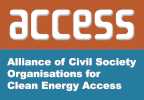|
|
| (468 intermediate revisions by 4 users not shown) |
| Line 1: |
Line 1: |
| | + | <div class="header-banner header-banner-country-portal"> |
| | + | <div class="grid grid-collapse stretch-items vertical-middle"> |
| | + | <div class="width-1-3 header-banner-image"> |
| | + | <center>[[File:Header_Portal_Mozambique.svg|800px|link=]]</center> |
| | + | </div> |
| | + | <div class="width-1-3 header-text-large"> |
| | + | <div class=""> |
| | + | = '''Mozambique''' = |
| | + | = Off grid Knowledge Hub = |
| | + | </div> |
| | + | </div> |
| | + | <div class="width-1-3"> |
| | + | <svgmap width="100%" color="#79d248" mark="mz" mark-color="#ffc714" flag="true" flag-size=""></svgmap> |
| | + | </div> |
| | + | </div> |
| | + | </div> |
| | | | |
| − | = Off-grid energy Companies and Financial Institutions - Need for Collaboration = | + | <div class="grid"> |
| | + | <div class="width-3-4"> |
| | + | == Country Information - Mozambique == |
| | + | The '''Republic of Mozambique''' is located on the south-eastern coast of Africa and has a surface area of 801,590 square kilometres. It is bordered by South Africa, Swaziland, Zimbabwe, Zambia, Malawi, Tanzania, and separated by the Indian Ocean from Madagascar. The country is divided into ten provinces, and a provincial capital city. It is one of the poorest countries in the world, and the 7th poorest in Africa with a GDP per capita of USD 1281 (2019), a total GDP of USD 14.96 billion (2019), and an annual GDP growth of 3.11% (2018). [[Mozambique- Country Information|Read more...]] |
| | | | |
| − | = Off-grid Energy Companies (OECs) = | + | <div class="grid stretch-items"> |
| | + | <div class="width-1-3 box box-green">'''Background''' |
| | + | * [[Mozambique- Country Information|Country Profile]] |
| | + | * [[Mozambique Electricity Situation|Electricity Situation]] |
| | + | *[[Mozambique Renewable Energy Potential|Renewable Energy (RE) Potential]] |
| | + | * Energy Access Situation |
| | + | </div> |
| | | | |
| − | Off-grid energy companies (OCEs) in this article refers to those companies in Africa that sell solar energy systems based on [[Fee-For-Service or Pay-As-You-Go Concepts for Photovoltaic Systems|PAYG model]] (i.e the total cost for the energy system is broken down into weekly and montly payments. The customers usually make a small downpayment in the beginning and then make small weekly and monthly payment for using the system and finally own the system. In case of failure to pay, the OECs remotely switch off the energy systems or in cases reposses them). <br/>
| + | <div class="width-1-3 box box-green">'''Institutional Set-up''' |
| | + | * [[Institutional Framework in Mozambique|Institutional Framework]] |
| | + | * [[Policy Framework and Energy Access Strategies in Mozambique|Policy Framework & Energy Access Strategies]] |
| | + | * Energy Access Programmes |
| | + | * Development Actors |
| | + | </div> |
| | | | |
| − | These are the fastest growing companies with an average of 500 customers per day.
| + | <div class="width-1-3 box box-green">'''Cross-Cutting Issues''' |
| | + | * [[Doing Business in Mozambique]] |
| | + | * Humanitarian Energy-Nexus |
| | + | * Impact of COVID-19 |
| | + | </div> |
| | + | </div> |
| | | | |
| − | == OECS - Shift from Energy Providers to Consumer Finance ==
| |
| | | | |
| − | To increase their revenue and to keep ahead of competitiors, there is a natural tendeny for OECs to also provide secondary loans along with the PAYG model for the energy systems, to existing customers, for activities such as buying a motobike or other appliances. For the secondary loans also, the energy system will act as a control point for loan repayment. In case of failure to pay on time, the energy system is switched off and the secondary assests might also be repossessed.
| |
| | | | |
| − | Along with added revenue, the other benefits of providing consumer finance are:
| + | == Information on RE Technologies for Mozambique == |
| | + | <div class="grid grid-collapse portals-wrapper"> |
| | + | <div class="width-1-1"> |
| | + | <div class="portals cross-cutting-issues"> |
| | + | <div class="portal">[[file:icon-solar.svg|150px|link=Portal:Solar|]]<br />[[Mozambique Solar Hub|Solar Home Systems]]</div> |
| | + | <div class="portal">[[file:icon-cooking.svg|150px|link=Portal:Cooking|]]<br />[[Mozambique Cooking Energy Hub|Improved Cookstoves]]</div> |
| | + | <div class="portal">[[file:icon-mini-grid.svg|100px|link=Portal:Mini-grid|]]<br />[[Mozambique Mini-grid Hub|Mini/Nano grid]]</div> |
| | + | <div class="portal">[[file:icon-productive-use.svg|100px|link=Portal:Productive Use|]]<br />Productive Uses of Energy</div> |
| | + | </div> |
| | + | </div> |
| | + | </div> |
| | | | |
| − | *For many customers in rural areas, buying energy services from OECs might be the '''first time they had access to financial services. Therefore the PAYG model sets the background for more financial activities.'''
| |
| − | *OECs '''promote mobile transactions''' for loan repayment reducing tthe transaction cost.
| |
| | | | |
| − | <br/>
| |
| | | | |
| − | However, OCEs companies are not financial institutions and in many countries they are not allowed to offer secondary loans (except for energy systems). Therefore, there is a need as well as opportunity for successfull collaboration between OECs and Financial institutions to further one another's interest.
| + | <div class="specials"> |
| | + | == Highlights == |
| | + | <div class="grid stretch-items"> |
| | + | <div class="width-1-2 width-m-1-2 card">[[file:Webinar icon3.svg|50px]] [https://register.gotowebinar.com/register/1648663127925031180 State of Play: Solar home system (SHS) Market in Mozambiques]</div> |
| | + | <div class="width-1-2 width-m-1-2 card">[[file:Sample-2.jpg]] [[Portal:Mozambique|Help Manual on how to contribute to the hub]]</div> |
| | + | </div> |
| | + | </div> |
| | | | |
| − | = Financial Institutions =
| |
| | | | |
| − | Financial institutions in sub-saharan africa are classified by '''large loan size, high margin and low business volume''' which is the opposite of financial services to the base of the pyramid (BoP). BoP are '''assest-led, low balance, high-volume''' business.Therefiore, financial institutuions have not been able to establish a commercially viable channel to reach out to the bulk of the african markets mainly due to:
| |
| | | | |
| − | *Entry-level accounts for low-income clients are likely to have low balances, make few transactions and use of fixed physical infrastructure such as bank branches and automated teller machines (ATMS) which in end might result in loss rather than profit, <span style="font-size: 13.6px; line-height: 20.4px;">for the bank.</span>
| + | == Mozambique Off-grid Practitioners Group == |
| − | *Due to issues like high-collateral requirement, time-consuming applications and inefficient cash management and inefficient cash management, financial institutions mostly focus on the salaried, relatively better-off segments of their markets. <br/>
| + | <div class="grid grid-collapse"> |
| | + | <div class="width-1-2">{{Mozambique Group}}</div> |
| | + | <div class="width-1-2">[[File:Ask_a_question.svg|link=|alt=|center|150x150px]]<div class="button-link" style="display: inline-block">[[Group talk:Mozambique Off-grid Practitioners Group|Ask a question]]</div>[[File:Moz_Group.svg|link=|alt=|center|150x150px]]<br/> |
| | + | <div class="button-link" style="display: inline-block">[[Group:Mozambique Off-grid Practitioners Group|Join the Mozambique Off-grid Practitioners Group]]</div> |
| | + | </div> |
| | + | </div> |
| | | | |
| − | <br/>
| |
| | | | |
| − | Therefore, the OECs present a unique opportunity for financial institutions to reach the low-income population in a viable and cost-effective manner.
| + | == Latest Articles on Mozambique == |
| | + | <div class="grid stretch-items"> |
| | + | <div class="width-1-3 box">[[Mozambique_Energy_Situation|Lorem ipsum dolor sit amet, consetetur sadipscing elitr, sed diam nonumy eirmod tempor ]]</div> |
| | | | |
| − | == Resources of Off-grid Energy Companies and Financial Institutions == | + | <div class="width-1-3 box">[[Mozambique_Energy_Situation|Lorem ipsum dolor sit amet, consetetur sadipscing elitr]]</div> |
| | | | |
| − | The table below shows the simplified analysis of the resources of off-grid energy companies and financial institutions:
| |
| | | | |
| − | {| border="0" cellspacing="1" cellpadding="5" style="width: 100%;"
| + | </div> |
| − | |-
| |
| − | | <br/>
| |
| − | | style="background-color: rgb(79, 129, 189);" | <span style="color: rgb(255,255,255)">'''Off-grid Energy Companies'''</span>
| |
| − | | style="text-align: center; background-color: rgb(79, 129, 189);" | <span style="color: rgb(255,255,255)">'''Financial Institution'''</span>
| |
| − | |-
| |
| − | | rowspan="6" style="background-color: rgb(219,229,241)" | '''Assets'''
| |
| − | | style="width: 106px;" | Agent network
| |
| − | | style="width: 324px; text-align: center;" | Branch network
| |
| − | |-
| |
| − | | rowspan="1" colspan="2" style="text-align: center; width: 530px;" | IT system for account management<br/>
| |
| − | |-
| |
| − | | rowspan="1" colspan="2" style="text-align: center; width: 530px;" | customer relationship<br/>
| |
| − | |-
| |
| − | | style="width: 324px;" | Cloud-based customer relation management (CRM) systems
| |
| − | | style="width: 200px; text-align: center;" | banking expertise
| |
| − | |-
| |
| − | | style="width: 324px;" | Leverage over customers
| |
| − | | style="width: 200px; text-align: center;" | credit assessment
| |
| − | |-
| |
| − | | style="width: 324px;" | <br/>
| |
| − | | style="width: 200px; text-align: center;" | banking license
| |
| − | |-
| |
| − | | rowspan="3" style="background-color: rgb(219,229,241)" | '''Financial products'''
| |
| − | | style="text-align: center;" rowspan="1" colspan="2" | Loans<br/>
| |
| − | |-
| |
| − | |
| |
| − | | style="text-align: center;" | Saving accounts
| |
| − | |-
| |
| − | |
| |
| − | | style="text-align: center;" | Money transfer services
| |
| − | |-
| |
| − | | style="background-color: rgb(219,229,241)" | '''key strengths'''
| |
| − | | Ability to reach lower-income populations at scale, profitably with financial services
| |
| − | | style="text-align: center;" | Banking license and know -how
| |
| − | |-
| |
| − | | style="background-color: rgb(219,229,241)" | '''key weakness'''
| |
| − | | banking license and know-how
| |
| − | | style="text-align: center;" | Ability to reach lower-income populations at scale, profitably, with financial services
| |
| − | |}
| |
| | | | |
| − | <br/>
| |
| | | | |
| − | = Reasons for Working Together = | + | == Funding == |
| | + | <div class="grid"> |
| | + | <div class="width-1-2 box" style="background: none; ">[[file:logo-giz.png|280px|link=https://giz.de/en]] </div> |
| | + | <div class="width-1-2 box" style="background: none; ">[[File:EnDev-Logo NEW.PNG|240px|link=https://endev.info]]</div> |
| | | | |
| − | == Large Portfolio of loans ==
| + | This portal is funded and developed in collaboration with the GIZ programmes Green People’s Energy for Africa and Energising Development Mozambique to enhance knowledge exchange and sharing among the Mozambican energy practitioners. |
| | + | </div> |
| | | | |
| − | Most of the OECs started out as energy system retailers but with progress, have amassed a large portfolio of loans. Managing these large portfolio of loans is outside their core competence and requires skilled financial capabilities. The loan also has to be refinanced.<br/>
| |
| | | | |
| − | For example, if an installed system cost on average USD 150, then to reach 1 million consumers, OECs will have to raise around USD 150 million in consumer loans. As the sector expands the consumer loan will also increase. Because of the possibility to remotely switch off the energy devices in cases of no payments, OECs loan have higher repayment rate than their borrower's profile will suggest. Therefore, OECs have the infrastructure to manage small loans offered to a relatively unknown customers.
| + | </div><!-- End .width-3-4 --> |
| | | | |
| − | On the other hand, financial institutions have the competence and infrastructure to mange consumer credit risk and to provide loans. <span style="font-size: 13.6px; line-height: 20.4px; background-color: rgb(255, 255, 255);">The OECs offer to increase the Bank's customer base but it will depend on the bank's ability to profitable serve those customers or not.</span>
| + | <div class="width-1-4"> |
| − | | + | <div class="hidden-element"> |
| − | == Access to Low cost Capital ==
| + | == Offers == <!-- Keep this for screenreaders --> |
| − | | + | </div> |
| − | Financial Instituions <span style="font-size: 13.6px; line-height: 20.4px;">can also fund a portfolio at a lower cost than that of OECs using long term deposits as compared to commercial debt. </span><br/>
| + | <div class="box offers">{{MozBoxnews}}</div> |
| − | | + | <div class="box offers">{{Boxpublications}}</div> |
| − | <span style="font-size: 13.6px; line-height: 20.4px;">A study among MFI account in sub-saharan africa showed that the MFI accounts are mostly used for saving rather than borrowing. In 2015, the aggegate amount of MFI desposits in subs-Saharn africa was USD 5 billion. Should this amount be available to OECs, then this amount would be enough to finance consumer loans for </span>'''33 million TIER 2 solar home systems with a value of USD 150 each'''<span style="font-size: 13.6px; line-height: 20.4px;">.</span>
| + | <div class="box offers">{{Boxcompanies}}</div> |
| − | | + | {{Connect_with_us}} |
| − | For financial institutions, the energy portfolio has a good rate of return.
| + | </div> |
| − | | + | </div> |
| − | = Foreign Exchange Risk = | + | __NOTOC__ __NOEDITSECTION__ __NOTITLE__ |
| − | | |
| − | Most of the capital for OECs is raised in <span style="font-size: 13.6px; line-height: 20.4px;">hard currency such as USD or Euro from international equity investors </span><span style="font-size: 13.6px; line-height: 20.4px;">while the consumer loans are given out in the local currency. This exposes OECs to risks associated with currency exchange and in cases, the local currency is devalued, it will impose additionnal cost on the OECs which is unrelated to its business and operations.</span><br/>
| |
| − | | |
| − | <span style="font-size: 13.6px; line-height: 20.4px;"></span><span style="font-size: 13.6px; line-height: 20.4px;">A collaboration between OECs and the financial isntituties will allow it to tap into the consumer deposits which is in local currency. This will </span><span style="font-size: 13.6px; line-height: 20.4px;">migitage the risks associalted with currency exchange as both the consumer loans and the capital will be in local currency.</span> | |
| − | | |
| − | <br/> | |
| − | | |
| − | = How to Work together? =
| |
| − | | |
| − | <u>Through a close partnerships:</u> OECs and financial institutions can forge a close partnership where both the parties focus on their close competencies ie. the OECs focuses on retail sale of energy services and the financial institutions take care of consumer finance. Considering both the parties are ready to form a partnership, the following points will have to consider:
| |
| − | | |
| − | *Who underwrites the loan and which regulations are followed?
| |
| − | *Criteria for identifying the consumers as well as opening an account for them
| |
| − | *Integrating the payment technologies of OECs and financial systems
| |
| − | *Criteria for managing customer relation eg what brand to promote and how to communicate
| |
| − | | |
| − | <br/>
| |
| − | | |
| − | = Reference =
| |
| − | | |
| − | This article is based on the following publications
| |















